History: ARROW Region
In This Section:
pre-1492 | 1492-1821 | 1821-1845 | 1845-1861 | 1861-1865 | 1865-1877 | 1877-1900
People first reached Florida at least 12,000 years ago. Prehistoric Florida was home to a large number of plants and animals including large mammals that are now extinct such as the saber-tooth tiger, mastodon, giant armadillo, and camel. The peninsula of Florida was more than twice as large as it is now because the sea level was much lower than in the present day. The first Floridians settled in areas where a steady water supply, good stone resources for tool making, and firewood were available and they sustained communities through hunting and gathering. As the centuries progressed the native Floridians developed intricate and complex societies and were well established as self sufficient entities before contact with Europeans in the late fifteenth and early sixteenth centuries.
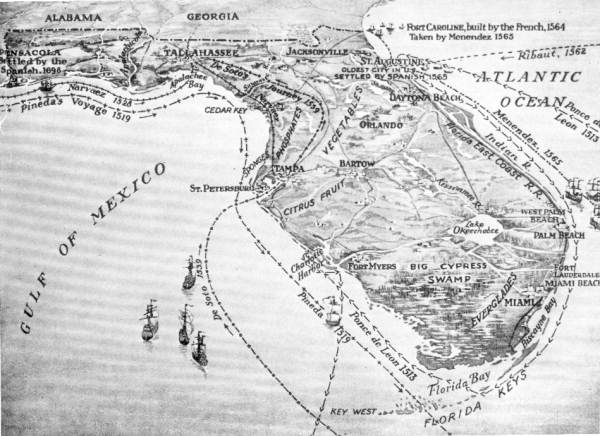 Map of Explorer's routes 1513-1562 |
Spanish exploration of Florida began in 1513. These expeditions began near present day St. Augustine, Key West and the Tampa Bay area. The Spanish were not the only ones to explore, settle and colonize Florida. The first recorded French settlement was erected in 1562 on the St. John's River. It was founded by French Huguenots (Protestants) searching for religious freedom. This settlement was easily overrun by Catholic Spanish forces who were settling over areas of Florida.
The first settlement in Florida was technically not St. Augustine as is the widespread notion. In 1559, Tristan de Luna y Arellano made an attempt to colonize what is today Pensacola Bay but he ultimately failed due to a series of misfortunes. St. Augustine was established in 1565 largely because the Spanish felt threatened by increased efforts by the French in establishing a foothold on the peninsula and in the New World. Pedro Menéndez de Avilés landed near present-day St. Augustine and named the area San Augustin (the Spanish version of St. Augustine). He captured, killed or expelled the French in the area and also attacked all settlers except for non-combatants and Frenchmen who professed belief in the Roman Catholic faith. Menéndez also captured Fort Caroline, a French fort and renamed it San Mateo.
The Spanish were soon joined by the English. In 1586 English captain Sir Francis Drake burned and looted the village of St. Augustine but this did not diminish Spanish control of Florida and their control over the peninsula was not really threatened until the 18th century despite a growing English presence in North America. The English colonists in the Carolina colonies were particularly hostile toward Spain. In 1702, led by Colonel James Moore, the Carolinians with Creek Indian allies attacked Spanish Florida. They destroyed the town of St. Augustine but could not capture the Castillo de San Marcos. In 1704 they destroyed the Spanish missions between Tallahassee and St. Augustine, killing many native people and enslaving others. In 1733 the English established the Penal Colony of Georgia led by James Oglethorpe and in 1740 the Georgians attacked Florida and assaulted the Castillo de San Marcos and held the fort and town in siege for more than a month.
During the Seven Years War (1756-1763), known as the French and Indian War in America, the British was in control of one of Spain's most prized possessions, Havana, Cuba. In 1763 at the conclusion of the war Havana was transferred back to Spain, but Madrid parted with Florida in the compromise and from 1763-1783 Great Britain and King George III ruled Florida. This is a little known fact in the history of the state today. Florida was not found in rebellion from London during the American Revolutionary War as most of the peninsula stayed loyal to the Crown.
Before the war broke out, the British implemented part of their ambitious plans for Florida. They split the vast land into two separate colonies, East and West Florida. East Florida was to be governed from St. Augustine while the Western half would have its capitol at Pensacola, which at the time was just a small military town. The boundary between the two sections was the Apalachicola River. Britain attempted to attract white settlers by offering land on which to settle and help for those who produced products for exportation. If the 13 original colonies had not rebelled in 1776 Florida may well have been converted into a flourishing English colony. The British also established ties with local Indians whom the British called Seminoles. When war broke out in 1775 Spain remained neutral although they were benevolently neutral on the side of the colonies. Spain officially joined France and the 13 Colonies in the war against Great Britain in 1779. In 1781 they helped to seize Pensacola Bay from the British in what was the largest and most significant battle fought in Florida. At the Treaty of Paris in 1783 the rest of Florida was transferred back to Spain.
The Second Spanish Period lasted from 1783 until 1821. Beginning in 1783, colonists as well as settlers from the infant United States came pouring in 1783 when the British evacuated the peninsula. Many of the new residents were lured to Florida by favorable terms for acquiring property, mainly land grants. Others who came were escaped slaves, trying to reach a place where their U.S. masters had no authority and effectively could not reach them. This pattern continued, troubling the neighboring Deep South states of Georgia, Alabama, and South Carolina whose economies were driven by chattel slavery.
In 1812 a small group of settlers in East Florida rebelled and declared their independence from Madrid. The Spaniards quickly and easily disposed of the rebels but the writing was on the wall. Spanish Florida was growing closer to the United States and farther away from King Joseph Bonaparte and Spain. Spain technically remained neutral during the War of 1812 (1812-1815) in North America but because of alliances employed in Europe, Spain let Great Britain use Pensacola as a naval base.
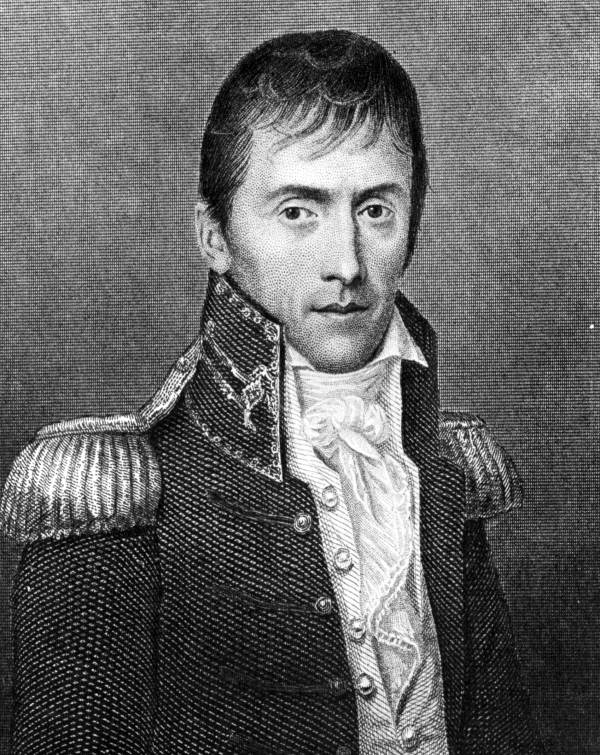 Portrait of Military Governor, Andrew Jackson |
Florida in 1821 was a melting pot. People from all over the nation and world lived in the peninsula. Many of the residents were escaped slaves who had sought refuge within the Spanish Colony. Over the next twenty four years Florida would grow exponentially and be transformed into a Deep South state dependent on slavery and deeply tied to its sister Southern states of Georgia and also South Carolina which would come into play in 1861 when the state left the Union.
As settlers flocked to Florida, many sought a new and better life, feeling Florida was a land of opportunity. Florida was the nation's but, more importantly, the South's newest frontier. Despite over three hundred years of Spanish, British and French rule, Florida was largely a virgin land to whites in the 1820's. It was considered part of the “old Southwest” which included Alabama, Mississippi, Louisiana, Tennessee, Arkansas, and eastern Texas and can account for why many felt Florida was a land of opportunity where settlers could begin new lives. This attitude is somewhat similar to that which would fuel the westward expansion movements of the 1840's and 1850's.
Most of the settlers came to the territory from the older Southern plantation areas of Virginia, the Carolinas, and Georgia. The Virginia planters were more conservative and even though they were slave owners they were not the fire eaters that would lead the state to secession in 1861. These Virginia planters made up the majority of the government of Florida in the Territorial period.
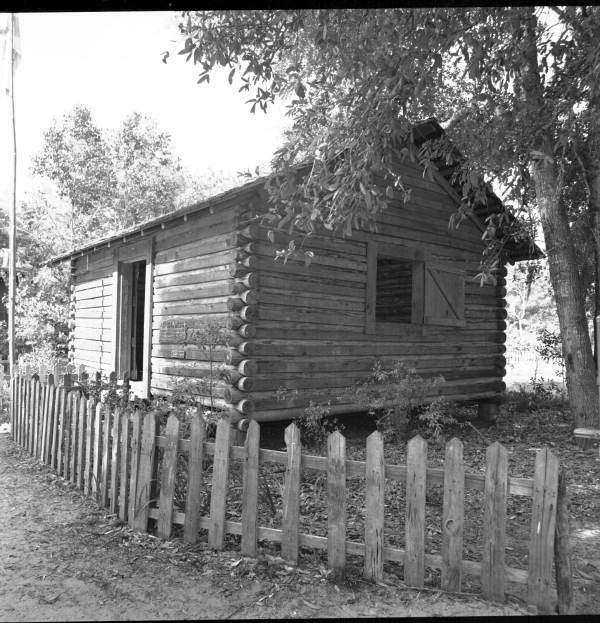 Replica of the Original Capitol Building in Tallahassee constructed in 1823 |
In 1821 when Florida became a United States Territory, the land held fewer than 8,000 people including slaves, but by the mid 1830's immigration to Middle Florida had caused the population of this region alone to swell to over 35,000. As Florida's population increased through immigration, so did pressure on the federal government to remove the Indian people from their lands. Indian removal was popular with white settlers because the native people occupied lands that white people wanted and because their communities often provided a sanctuary for runaway slaves from northern states. Under President Andrew Jackson, the U.S. government spent $20 million to remove Indians from the land. Some Indians migrated "voluntarily." Some were captured and sent west to Oklahoma and others escaped into the Everglades, where many remain today.
The last decade of the territorial phase saw Florida ravaged by war. The Second Seminole War, which last from 1835-1842 was a direct result of the forced removal of Indians from their land. By the terms of the Treaty of Paynes Landing (1832), the Seminole were forced to migrate west of the Mississippi River within 36 months. By 1834, 3,824 Indians had made the move. The largest faction of Seminoles, led by Chief Osceola refused to obey the treaty. He vowed to fight to the death and in response to his resistance, he was briefly imprisoned. A few months following his release, he commenced attacks on the Americans. On December 28, 1835 Osceola murdered Indian agent Wiley Thompson. The same day, Major Dade and his U.S. soldiers were ambushed by 300 Seminole warriors near Fort King (near present day Dade City in Central Florida). This battle began the Second Seminole War. The natives retreated into the Everglades, began guerilla tactics against U.S. forces and fought desperately for more than seven years. Osceola was arrested and confined first at Saint Augustine, then Fort Moultrie at Charleston, South Carolina where he died on January 30, 1838. By 1842, the Seminoles were nearly exterminated. Over 4,000 surrendered and were deported to Oklahoma.
By the time the first territorial convention to discuss statehood met at St. Joseph in 1838 the state had was home to 48,223 of which 21,132 were slaves. The state's regions also bickered with each other over the question of statehood. East Florida, jealous of the power and influence Middle Florida would have in the political arena based on the region's rapid growth in population and wealth, voted 614-255 against statehood. Middle Florida voted 1,152-226 for it and West Florida 732-324 in favor of the resolution. The constitutional convention was only made possible because the legislature had placated the West and East by giving them greater proportional representation than Middle Florida. By 1839 Floridians had voted in favor of statehood in one final referendum after the close of the constitutional convention by a narrow 2,065-1,961 margin. In spite of the vote, statehood would not come to Florida until 1845. Plantations were concentrated in Middle Florida, and their owners established the political tone for all of Florida until after the Civil War.
 David Levy Yulee, Florida's First Senator, the First Jewish Senator in the United States Senate and one of Florida's Senators to the Confederate States of America |
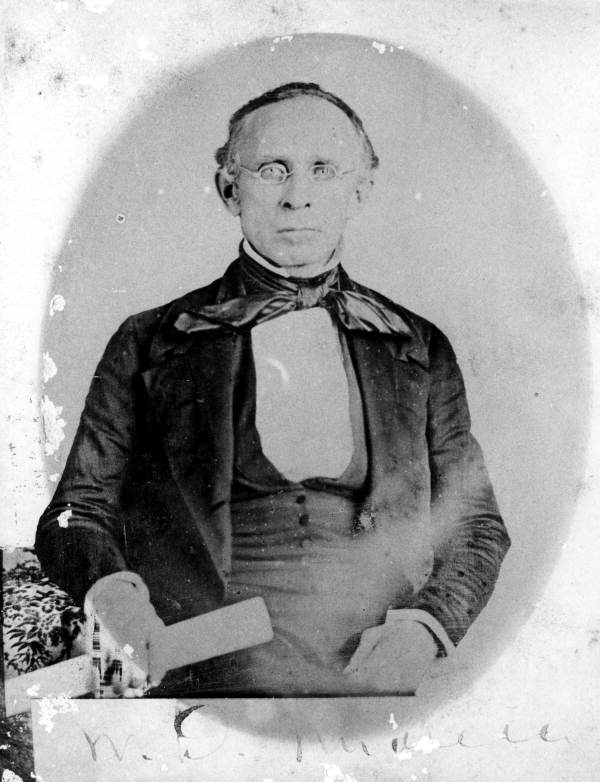 First Governor of Florida, William Moseley |
 Ice Maker constructed by John Gorrie in his house in Apalachicola as the precuror to Air Conditioning |
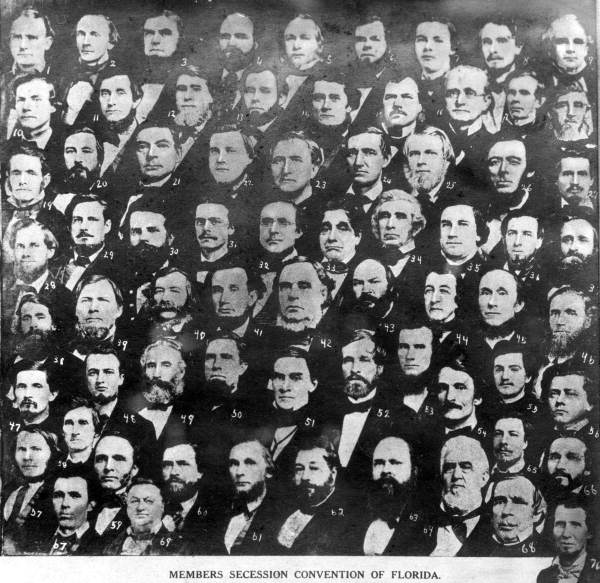 Portrait of the Members of Florida's Secession Convention |
Abraham Lincoln did not appear on the ballot in Florida in 1860 and Vice President John Breckenridge carried the state as a Southern Democrat. On January 10, 1861 Florida voted 62-7 to secede from the Union and became the third state to do so following South Carolina and Mississippi out of the United States. The Ordinance of Secession was read from the steps of capitol building in Tallahassee and Florida prepared for war.
Civil War in Florida (1861-1865)
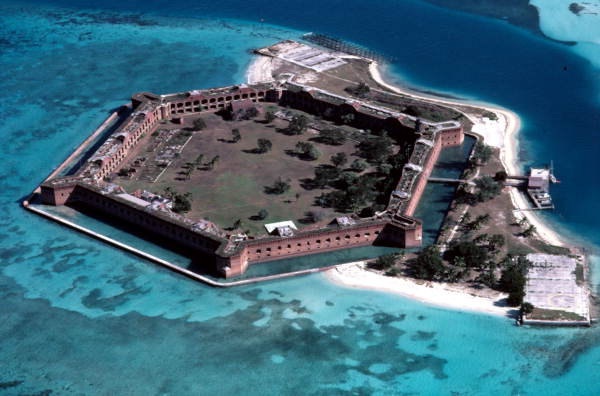 Fort Jefferson near Key West, occupied by the Union Army during the Civil War |
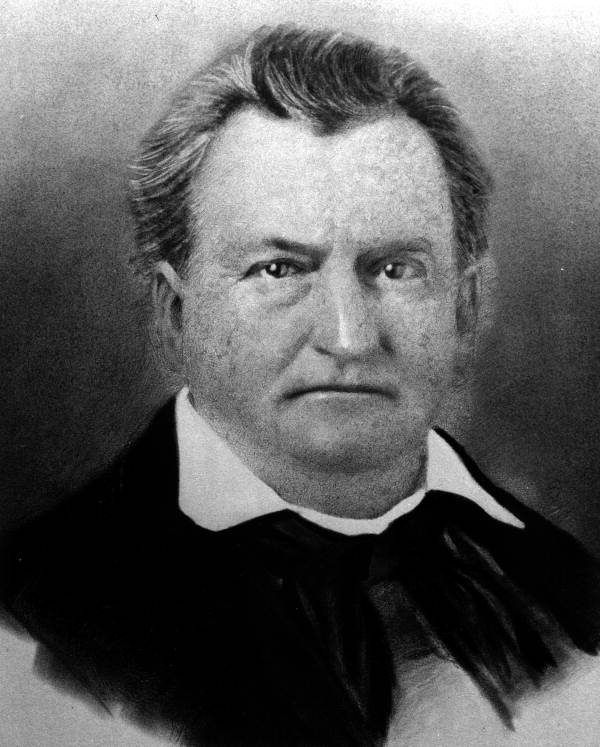 Governor John Milton, who led Florida during the Civil War and committed suicide in April, 1865 as the Confederacy fell |
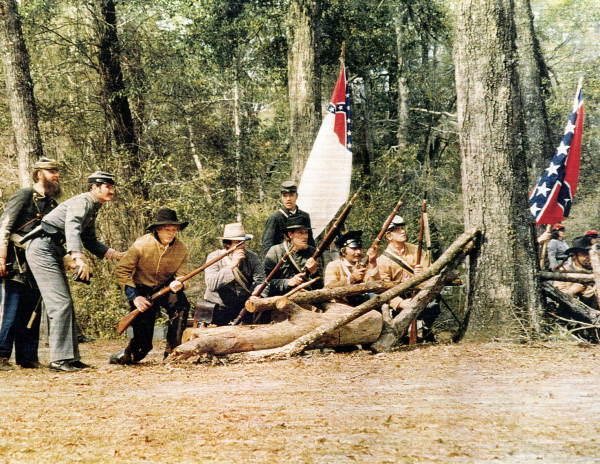 Reenactment of the Battle of Natural Bridge south of Tallahassee |
Floridians faced reconstruction with mixed emotions and goals. Half of the population was newly freed and looked to the federal government for support and help in creating new lives, while the other half of the population was bitter and embattled and this led to the creation of local chapters of the Ku Klux Klan and other racist societies. Former plantation owners tried to regain pre-war levels of power and production by hiring former slaves to raise and pick cotton. Much of the land came under cultivation by tenant farmers and sharecroppers, both African American and white. The recreation of the plantation economy was basically a failure.
Reconstruction began in earnest in 1868 and during this period, Republican officeholders tried to enact sweeping changes within Florida which included improving conditions for African Americans. Florida was one of the last troops to come out the reconstruction period and in fact this did not occur until 1876 under controversial and mysterious circumstances. The election returns in the 1876 Presidential election were disputed in Florida, South Carolina and Louisiana. Democrat Samuel Tilden had won the popular vote but the Electoral College returns were disputed and claims were made that the Republicans promised to pull Federal Troops from Florida, South Carolina and Louisiana if they swung the election to the Republican Rutherford B. Hayes. The three aforementioned states did so, and Hayes was rewarded with the White House. The troops were removed in 1877, but the Democrats soon gained control of the Governor's Mansion and the Legislature and enfranchisement of the state's blacks was quickly repealed. The Democrats would then control the Florida state government for almost 100 years (until the 1970's).
The Agricultural and Tourism Boom in Florida (1877-1900)Commercial agriculture and cattle raising grew immensely in the years following the Civil War. The Florida citrus industry grew rapidly during this period as well and many business and ordinary citizens began to look at the peninsula as a place to start a new life. Beginning in the 1870s, residents from northern states visited Florida as tourists to enjoy the state's natural beauty and mild climate. Steamboat tours on Florida's numerous rivers were a popular attraction for these visitors.
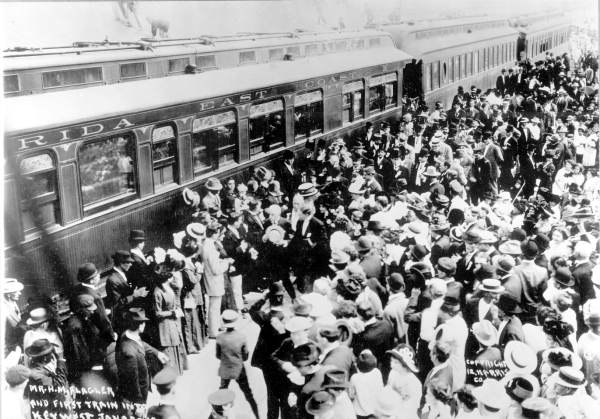 Henry Flagler's East Coast Railway |
After the U.S. Civil War, cotton production declined due to several factors, including the loss of slave labor. The timber industry rose to take its place. There was high demand for wood for building and fuel as well as for turpentine and rosin. In 1874, the US Corps of Engineers secured a 6-feet deep channel at low water that was 100 feet wide throughout the length of the Apalachicola River. The completion of the Pensacola and Atlantic Railroad to the east bank of the Apalachicola River further opened the areas's forests to large-scale commercial logging. At the beginning of the 20th century, Florida's main economic products in the Apalachicola River area was timber- or agriculture-based.
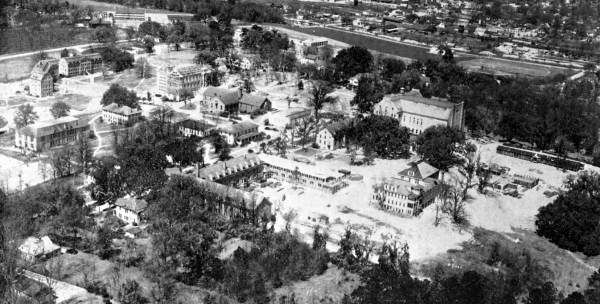 Florida A&M University in Tallahassee |
 10th United States Cavalry in Tampa on their way to Cuba during the Spanish-American War |
The first decade of the new century and World War I served to stimulate Florida's economic growth. The real estate industry exploded in this period and would grow even more during the decades to follow. Florida became a haven for tourists with the growth of the automobile industry as many more tourists flocked to the Sunshine State from the North. Florida's population also began to grow during this period as many of the new visitors to the state decided to stay and make a new life in the state.
All was not rosy in Florida and by 1926 things turned southward. Florida's economic bubble burst in 1926, when money and credit ran out. Banks and investors abruptly stopped trusting "paper millionaires”. The state was also affected by natural occurrences as several severe hurricanes swept through the state in the 1926 and 1928, further harming Florida's economy. In this respect, the state had already lived through economic troubles and hardships before the great depression. The state's citrus and agricultural industries were also hurt by a fruit fly epidemic in 1929 that cut the state's production by 60%.
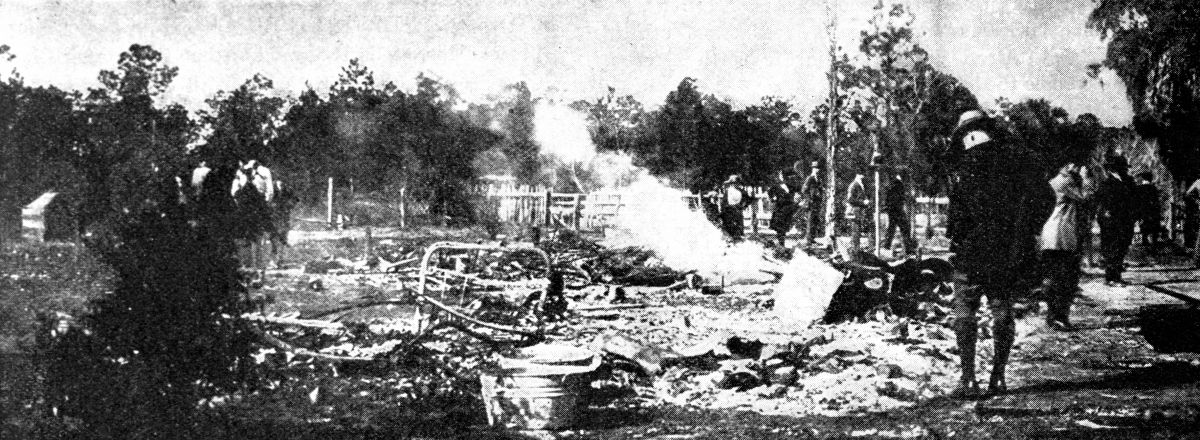 Deconstruction of the Black Town of Rosewood in 1923 |
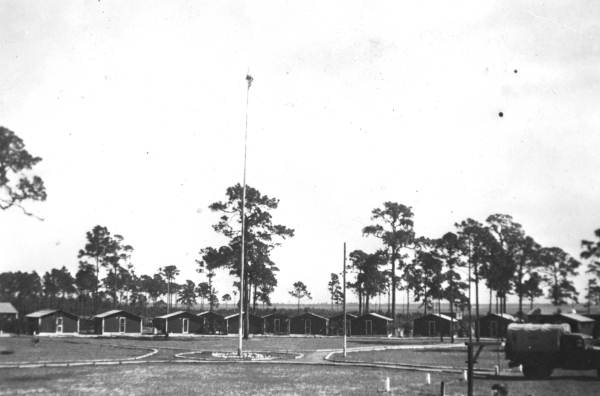 CCC Camp at Highland Hammock State Park during the New Deal Era |
The year 1937 also saw steps towards equal rights for the state's African-American citizens as poll taxes were repealed. Most African-Americans in Florida were still working as farm laborers at this time but more and more were moving to urban areas. Many African-American women worked as domestic servants while men worked in forestry, railroad industry, or as craftsmen.
The timber industry of north Florida was established by Alfred I. DuPont and his brother-in-law, Ed Ball, in the 1930's and owned more than one million acres in Florida. The St. Joe Company is one of DuPont's legacy.
The New Deal programs forever changed the outlook many Floridians had toward the role of the Federal Government in their lives. Rural Florida needed support for their farms supports and urban Florida needed jobs. President Roosevelt was able to accommodate Southern politicians and appease conservative constituents.
The Agricultural Adjustment Act provided subsidies to many farmers in Florida's Panhandle. The National Recovery Act also bolstered wages and protected the status of Florida's weak labor unions while road construction projects were implemented under the PWA. Florida was the last Southern state to enact unemployment insurance measures in conformity with the Social Security Act even though the state was home to numerous retirees.
Florida in World War II (1941-1945)
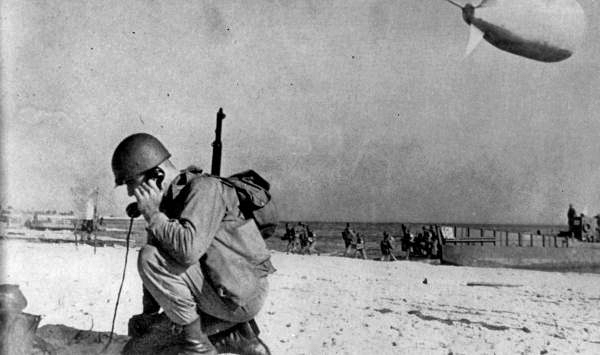 Amphibian Landing Training at Camp Gordon Johnston during WWII in the Florida Panhandle |
In late 1943, Carrabelle Beach and Dog Island, while they were a part of Camp Gordon Johnston, were used by the U.S. Army 4th Infantry Division to train for the Normandy Invasion on D-Day, June 6th, 1944. The Amphibious Training Center had been officially closed, but it was reopened and staffed for the purpose of training for this important mission. Although the troops had trained for over three years, the amphibious training conducted on this site was the last step before shipping out to England for the invasion. On D-Day, the first amphibian infantry assault teams to arrive on French soil were from the 4th Infantry Division at Utah Beach. On June 6, 2000, the Camp Gordon Johnston Association extracted a small amount of soil from this site and delivered it to the National 4th Infantry Division Association to be placed in the Association's monument in Arlington, VA. The U.S. Department of Defense's World War II Commemoration Committee in 1995 named the Camp Gordon Johnston Association an official “Commemorative Community.
 Tanker Gulfland attacked and sunk by German U-Boat during WWII of the coast of Florida |
In 1944 the U.S. Supreme Court outlawed a system of all-white primary elections that had limited the right of African Americans to vote which was another step towards equal rights and foreshadowed the Civil Rights movement of the 1950's and 1960's.
Highway and airport construction accelerated and by war's end, Florida had a modern network.
Post War and Civil Rights Era in Florida (1945-1970)North Florida supported Dixiecrat and State's Rights candidate Strom Thurmond over President Harry S Truman in 1948, highlighting the growing division between rural Florida and the growing towns of South Florida which were becoming dominated by retirees from the North. In 1950 Florida still trailed Virginia, North Carolina, and Georgia in population among Southern states, but the state was growing much more quickly than the rest of the country and region. Florida was also rapidly emerging as an urban society, much to the dismay of Florida's rural politicians who largely supported segregation. Segregation officially ended in the state in 1954 with the Supreme Court's decision in Brown v. Board of Education and in time the state's schools were integrated. The Baker v. Carr decision in the state's Supreme Court established proportionate districts ending the domination of the state by the Pork Barrel Gang, or politicians from rural North Florida. Governor LeRoy Collins led the charge to integrate schools with support from the state's black population. In 1968 Florida elected its first Republican Senator since Reconstruction.
Tourism replaced agriculture as Florida's top industry. Generations of future farmers were turning to jobs in construction and hotel management when they used to consider agribusiness as a career. Miami Beach became a haven for tourists from New York and the Northeast and the entire focus of the state seemed to shift southwards during this period.
Modern Florida (1970-Present)
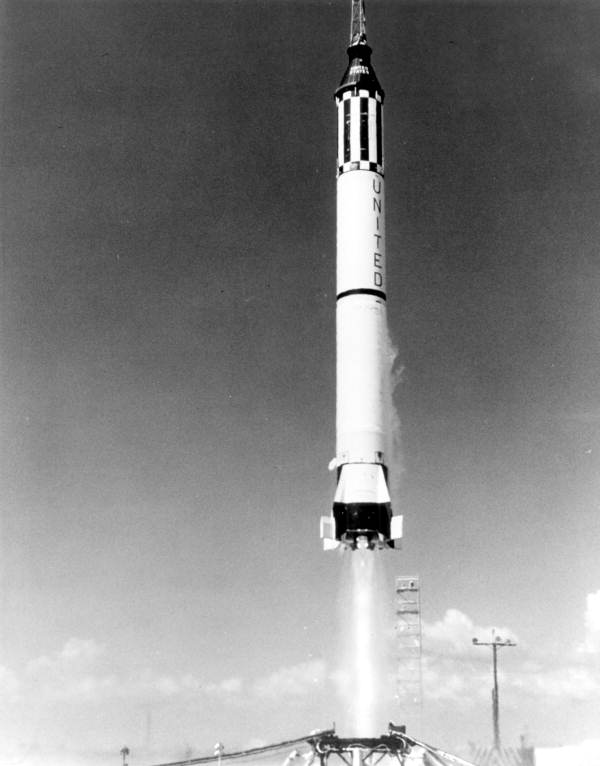 First space launch at the Kennedy Space Center on Florida's East Coast |
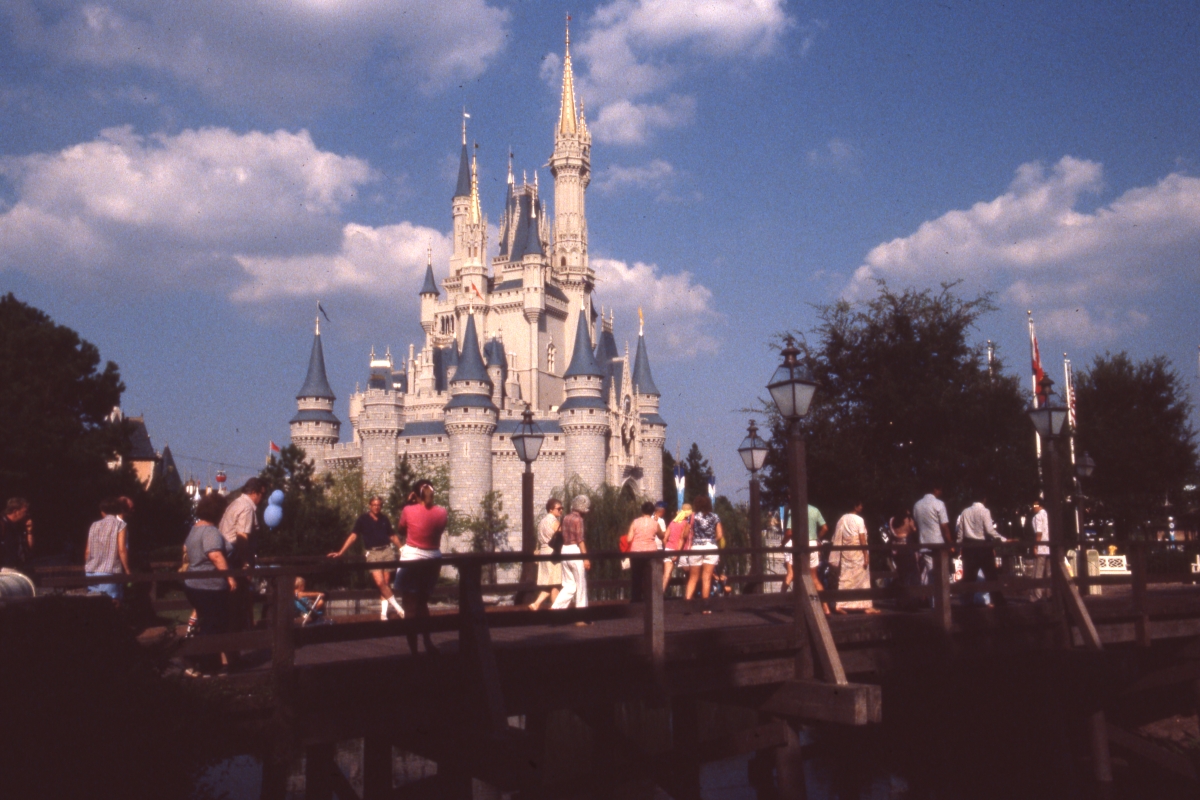 Cinderella's Castle at the Magic Kingdom in Orlando |
Beginning in the 1990's, the St. Joe Company evolved from a lumber company (originally known as St. Joe Paper Company) into a land development and real estate company. The company has identified several major real estate projects in the Apalachicola River region to be developed during the early part of the 21st century. These projects have the potential to dramatically alter the culture and lifestyles of much of the middle and eastern Florida Panhandle.
Modern Florida is home to over 17 million citizens due in part to a large influx of immigrants from Latin America, mainly Cuba. The 2000 census saw Hispanics make up 16.8% of the state's population. Over the past 150 years Florida has grown from a backwater rural frontier society in the nation's fourth most populous state and the nation's number one tourist destination.
Sources:
Fernald, Edward A. and Elizabeth D. Purdum, 1996. Atlas of Florida, University Press of Florida, Gainesville, Florida, 280 pp.
Gannon, Michael. Florida, A Short History. Gainesville: University Press of Florida, 1993
Tebeau, Charlton. A History of Florida. Coral Gables: University of Miami Press, 1972
U.S. Army Corp of Engineers, Website www.sam.usace.army.mil/op/rec/acf/history.htm. Accessed on April 6, 2004.
Weitz, Seth A. “The Rise of Radicalism in Antebellum Florida Politics, 1845-1856” (Master's Thesis, Florida State University, 2004)
Note: The content of the website has not been updated since 2005. The site remains online for it's value as legacy content and is unlikely to be updated.